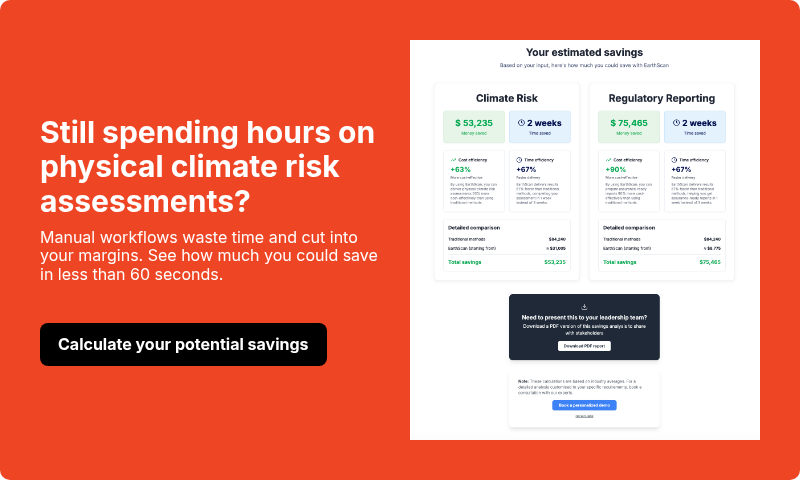Now that CSRD Wave 1 is behind us, the real learning begins.
Key takeaways
- Don’t over-prepare, just get started
Progress came faster for teams who ran first drafts and improved iteratively.
- Missing data was the biggest blocker
Many struggled to match assets with the 28 hazard types required by ESRS E1.
- You don’t need all 28 hazards
Focus on what’s material and defensible. Not every risk applies to every asset.
- Trial runs save hours later
Running pilots with EarthScan clarified workflows and boosted report quality.
- Automation = credibility and scale
Audit-ready, repeatable reports helped consultants serve more clients, faster.
- Collaboration is essential
Pairing sustainability leads with risk engineers produced stronger, more complete assessments.
- Reporting is just the start
Use CSRD filings to build long-term resilience, not just tick boxes.
For many consultants and their clients, FY24 started in confusion, progressed through some painful “Oh no…” realisations, and ended with greater clarity on what actually works.
In this conversation between Jessica Penny (Climate Policy & Strategy, Mitiga Solutions) and Wiebke Cundill (Team Lead, Natural Hazards & Climate Risks, HDI Global SE), we unpack what worked, what didn’t, and how to prepare better for FY25 and beyond.
📺 Prefer to watch? Catch the full webinar recording here:
“Just get started”, but do it smart
If there’s one takeaway from the first CSRD cycle, it’s this: over-preparation often kills momentum. Many consultants found success not by waiting for perfect data or full clarity on regulatory nuances but by starting, iterating, and learning by doing.
“Our part was almost easier than we thought once we just did it,” said Wiebke. “We focused less on every word in the regulation and more on delivering reports clients could use.”
Granularity: the biggest hurdle (and opportunity)
Two challenges surfaced repeatedly in FY24:
- How granular should reporting be?
- How do you handle incomplete or missing data, especially across large, region-based portfolios?
CSRD guidance isn’t always black and white. “Clients were unsure whether to go asset-level or regional,” noted Jessica. “And many panicked when they realised the data they needed didn’t even exist.”
The EU’s list of 28 hazards became a sticking point. “It’s indicative, not exhaustive,” Jessica reminded. “Focus on what’s material. If you can’t assess a hazard reliably, say so.”
Wiebke echoed this: “We’d rather be transparent about data limitations than fill a cell with a guess. That builds trust with clients and auditors alike.”
How EarthScan Disclose changed the game
For HDI and others, EarthScan Disclose brought clarity to complexity. Built by Mitiga, it’s a plug-and-play climate risk reporting tool that enables consultants to deliver audit-ready Excel reports in just a few clicks, no climate expertise required.
“We use EarthScan because it gives us sturdy, granular data down to precipitation levels and temperature thresholds,” said Wiebke. “That’s what allows us to move beyond compliance and into adaptation planning.”
With EarthScan Disclose, consultancies can:
- Upload a simple CSV with site locations
- Automatically generate reports aligned to ESRS E1
- Download Excel outputs that are auditor-ready and easy to share with clients
This is ideal for running trial reports, validating assumptions with assurance providers, and scaling CSRD reporting across hundreds of assets.
From compliance to resilience: a mindset shift
CSRD is not just a checkbox. For leading consultants, it’s a strategic opportunity to connect physical risk data to business decisions on capital investments, supply chain planning, and site resilience.
Wiebke said:
{{quote-1}}
She shared examples of how HDI teams used EarthScan outputs to identify sites most exposed to heat stress or heavy rainfall and integrate that into cooling system designs, flood mitigation, and business continuity planning.

3 starter tips for FY25
If you’re guiding clients through their first (or next) CSRD submission, here’s your essential starter pack:
- Just get started. Don’t wait for perfect. Trial runs now will save time later.
- Prioritise key sites. Focus on value-driving locations or those exposed to major business interruption risks.
- Collaborate across teams. Climate risk isn’t just for ESG. Involve risk engineers, ops, and finance early.
“When sustainability teams share EarthScan outputs with engineers and CFOs,” said Jessica, “the data finally clicks. It’s no longer abstract, it’s actionable.”
Ready to scale your CSRD offer?
With EarthScan Disclose, consultants can stop cobbling together datasets, translating vague hazard tables, or guessing what auditors will accept.
Instead, you can scale physical climate risk reporting for your clients faster, cheaper, and more credibly.
Whether you’re reporting on 1 site or 5,000, EarthScan Disclose simplifies your workflow and amplifies your value. Want to see how it works? Explore EarthScan Disclose today.







